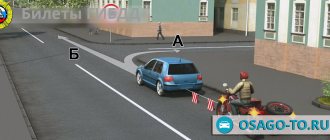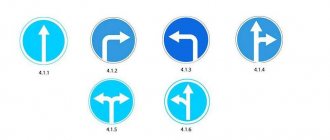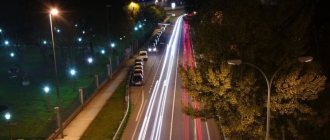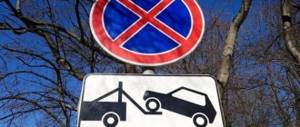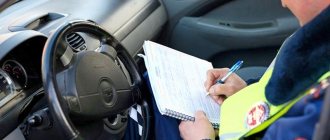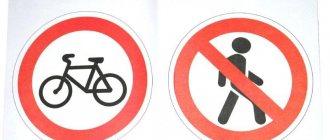A warning triangle is an indispensable attribute of any motorist, since traffic regulations prohibit vehicles that are not equipped with the appropriate sign from entering public roads. The warning triangle, or more correctly the “warning triangle,” has strict conditions of use and characteristics defined by law.
- 2 In what cases is it used
- 3 traffic rules
- 4 What to do if there is no sign
- 5 Fine for absence
What does a warning triangle look like?
The provisions of GOST 41.27–2001 apply to the emergency stop sign. According to the standard, the sign is a red equilateral triangle. Russian GOST is based on the provisions of UNECE rules No. 27.
When purchasing a sign in a store, it must be accompanied by instructions for use.
All such signs are produced uniformly and must have the following characteristics:
- size - side length 50 cm ± 5 cm;
- material - plastic or plastic;
- presence of a reflective strip of at least 50 mm;
- the presence of a fluorescent strip with a total area of at least 315 cm2;
- one of the sides must be equipped with a metal stand to stabilize the sign on the asphalt.
Both stripes are necessary to attract the attention of drivers: the reflective strip significantly increases the visibility of the sign in daytime conditions, and the fluorescent stripe in night conditions.
Transportation of the sign in the cabin or trunk of a car must be carried out exclusively in a case that protects the element from damage.
Presence of an emergency sign in a car: legislative framework
When to place a warning triangle on the road. According to the law, there are three such situations:
- an accident occurred;
- the driver stopped where he shouldn't. For example, I stood under a “No Stopping” sign because I had a flat tire;
- the driver stopped in a place with poor visibility, for example, in fog.
How to put up a sign in case of an accident. There is a minimum distance that must be maintained between the vehicle and the sign:
- 15 meters - in the city,
- 30 meters - outside the city.
According to the rules, the driver himself must choose the optimal distance from the visibility conditions, but not less than these values. This means that at night in fog on a country road it is better to place a sign 100-150 meters away. Speeds on country roads are higher than in the city - other drivers must have time to brake.
This sign can be purchased as a set - it contains a first aid kit and a fire extinguisher. Or purchase separately
In what cases is it used
The warning triangle must be at a certain height above the roadway surface
A warning triangle is used to attract the attention of other road users in cases where the car owner's car may pose a danger to them.
Such situations include:
- traffic accident;
- towing a car with a faulty warning light;
- forced car stop in unintended places on the road surface or in places with insufficient visibility.
Drivers moving in the opposite direction or in the same direction must be able to notice the warning triangle and take measures to safely pass through the emergency area.
When to install
The structure must be installed in the following cases, in accordance with paragraph 7.2 of the traffic rules:
- In case of a traffic accident.
- When a vehicle is forced to stop in places where it is prohibited: in the middle of the road, at an intersection, etc.
- When a vehicle is forced to stop in places of poor visibility, due to which other road users cannot notice the vehicle in a timely manner: around a sharp turn, behind a hill, etc.
Also, the structure must be attached to the rear of the car when it is towed in the case when the hazard warning lights do not work, as defined in paragraph 7.3 of the traffic rules.
Traffic rules
The traffic rules approve the exact distance from the car to the stop sign, based on calculations of vehicle speed in various conditions:
- within populated areas, a warning triangle is installed at least 15 m before a vehicle in an emergency situation;
- outside populated areas, the sign is placed at least 30 m before the car.
The driver must not only comply with the provisions of the traffic rules when installing a sign, but also independently calculate the possibility of other road users noticing it. In conditions of reduced visibility (due to curves in the road, at night, in fog) or increased speed (for example, on a highway), the sign can be installed at a distance exceeding traffic regulations . It would not be superfluous to install a warning triangle 40 or 50 m outside the populated area.
When installing the warning triangle sign, you must wear a reflective vest
The warning sign must not pose an additional hazard to moving vehicles. For example, a sign placed after a sharp turn can provoke an additional accident - either with a stopped car or with the sign itself, which can be dangerous at high speeds.
A warning triangle near the stopping place does not replace the driver’s obligation to take other measures to notify road users of the current emergency situation. Thus, from 2021, drivers who make a forced stop in places not intended for this purpose due to an accident or traffic accident are required to wear a reflective vest.
When forced to stop in the wrong place, the driver’s sequence of actions should look like this:
- Turn on the hazard warning lights.
- Wear a reflective vest.
- Install the warning triangle at the required distance.
Each participant in an accident is required to display his own sign to warn other drivers. It does not matter how many cars were involved in the accident. Roughly speaking, if 10 cars collided in an accident, 10 warning triangles should be installed.
In some situations, a stopped car can pose a risk of accident to cars moving in both directions of the road. This can happen in an accident without other participants, for example, when a car turns around on the median. In this case, the car owner must warn traffic participants in both directions; therefore, he is obliged to install two signs in oncoming lanes. If this is not done, then the driver can be completely legally fined by the arriving traffic police officers. Therefore, we can recommend that any car owner carry two warning triangles in the trunk of the car at once - in rare cases this may be necessary.
Requirements in Europe
The requirement for emergency stop warnings in a vehicle is imposed in all European countries except England, Germany, Holland, Malta and Sweden.
In some countries, such as Serbia, Croatia, Bosnia, Macedonia, Slovenia and Montenegro, the driver must have 2 signs at once if a trailer is attached to their vehicle. If the vehicle is moving without a trailer, there can only be one sign and it is placed at the rear of the vehicle.
In Cyprus, as well as in Romania and Turkey, drivers are required to carry two signs even if they do not have a trailer.
And in Spain, the obligation to carry 2 signs is assigned only to citizens of their own country. Foreigners are allowed to carry one badge, but are advised to purchase a second one. In all four countries, when a vehicle is forced to stop, the structure must be positioned in both directions in the lane where the car is located. If this is not done, the driver will be fined accordingly, including in Spain, where administrative sanctions can also be applied to foreigners who, by default, are not required to carry 2 signs.
Also, in some European countries, motorists are required to carry reflective vests. First of all, such vests should be used in the dark and in bad weather. In some countries, it is mandatory to wear it every time you get out of the car when stopping on the road (not in a parking lot).
How to legalize changes in the design of a vehicle so that you don’t have to pay fines...
What to do if there is no sign
The only recommendation for drivers who do not have a warning triangle included in their car is to immediately purchase one. Previously, drivers were allowed to use a red light instead of a sign, but modern traffic regulations have abolished this provision.
The warning triangle and its stop must not have sharp edges or corners
If the warning triangle is still not in the trunk of the car, the driver should take all measures to warn other road users about the emergency. To do this, you can use any available objects that will help attract attention and warn other participants about the danger that threatens them. In practice, such a means can be a bucket, a fire extinguisher, a first aid kit, bright clothes, etc. Of course, such an action will not help avoid a fine for the absence of a warning triangle - as soon as traffic police officers arrive at the scene of the accident, they will issue a decree. But stopping such a warning sign will help prevent an additional accident that threatens the health and property of both the driver and other road users.
At what distance should a warning triangle be placed?
The warning triangle must be in the car, in accordance with the rules of the road. If a traffic police inspector stops and does not find it, this could mean a fine for the driver.
Like all signs, its installation is subject to certain rules. One of them is the distance at which it should stand from the car. Moreover, it must be placed on the roadway both in the event of an accident and in the event of a stop due to a technical malfunction of the car. In populated areas it should be 15 meters, outside populated areas - 30 meters.
In addition, it must be installed on the bumper of the towed vehicle if its rear lights do not work. Another nuance of its installation is that in case of an accident it must be in the direction of travel, and if there are several participants in the accident, the number of signs must match their number. Although few people adhere to the last rule, they usually put up one sign, indicating the fact and location of the accident.
In what cases should it be used?
As a rule, a sign is placed on the road for several reasons:
- The driver was involved in an accident;
- The owner of the car witnessed an accident and went to provide assistance, abandoning his car;
- The driver felt ill and stopped in the wrong place;
- The owner of the vehicle was forced for some reason to stop in the wrong place;
- The driver stopped in a place where drivers may not notice the car and drive into it; children are boarding or disembarking in a vehicle that has the appropriate sign;
- The vehicle is in potential danger.
But this does not mean that you can arbitrarily throw a car anywhere, leaving a sign. If a traffic police inspector sees such a situation and does not find any compelling reason to stop, he will easily issue a fine.
Use of hazard warning lights and warning triangles
At a speed of 75 km/h, the driver needs at least 31 meters (1.5 seconds) to recognize the danger and react accordingly. Only with reflective hazard lights, cyclists and drivers have enough time to respond safely.
According to the rules of paragraph 7 of the traffic rules, any driver of a vehicle during an emergency stop is obliged to use:
- Portable warning triangle;
- Emergency alarm.
The traffic rules adopted by Decree of the Government of the Russian Federation dated October 23, 1993 N 1090 (as amended on December 21, 19) oblige vehicle owners to display a sign and turn on signal lights:
- To improve visibility in case of an accident;
- In cases of forced stop;
- When using a tug;
- When boarding children in vehicles.
In all of these cases, the warning triangle improves visibility thanks to an internal fluorescent stripe and a main triangle made of reflective materials. They increase the contrast of light against the background and increase the distance the driver can see when the vehicle is parked or towed.
GOST requirements for warning triangles
For all attributes that must be in a vehicle, there are certain GOST standards. Warning triangles are no exception. Let's consider the basic requirements for them:
- The warning sign should not only be in a passenger car. The law applies to trucks, buses, minibuses, and motorcycles with trailers. Operating these vehicles without it is punishable by a fine;
- The sign cannot be made independently due to strict requirements for its appearance;
- The shape is strictly in the form of an equilateral triangle, each side of which varies from fifty to fifty-five centimeters. The internal empty space must be at least seven centimeters. The thickness of the fluorescent layer is at least five centimeters;
- For a stable position of the sign, it must certainly be equipped with a support;
- The color is only red or orange.
You can learn more about the requirements and GOST from the video:
What do we have?
Let's take night conditions. For a passenger car, the headlights are located at a height of 0.5–0.7 meters above the ground, and the beam angle is at least 1% (10 cm/10 m). Theoretically, the light beam from the low beam should end at a distance of 50 meters (for a height of 0.5 meters) to 70 meters (for a height of 0.7 meters). For the purposes of this article, we can assume that the low beam headlights of a typical passenger car shine 60 meters ahead. It is at this distance that the driver will see the return light from the warning triangle.
